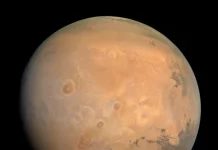
NASA’s Curiosity rover has just made a fascinating discovery on Mars — the largest organic molecules ever found on the red planet.
These complex carbon-based compounds were spotted in a rock sample that Curiosity first drilled back in 2013, in a region called Yellowknife Bay, believed to be the site of an ancient lake.
The discovery was published in the journal Proceedings of the National Academy of Sciences and adds to the growing evidence that Mars once had the right conditions to support life — or at least, the chemistry that could lead to it.
The new molecules found include decane, undecane, and dodecane, which each contain 10, 11, and 12 carbon atoms.
These are believed to be fragments of longer fatty acids, the same kinds of molecules that help form cell membranes in living things on Earth.
While these fatty acids can be produced by life, they can also form through natural processes like water reacting with minerals in hydrothermal systems — no life needed.
Because Curiosity’s onboard lab, called SAM (Sample Analysis at Mars), heats samples to look for molecules, scientists believe these shorter compounds may have broken off from longer fatty acids during testing.
To prove this, they ran experiments on Earth by heating similar compounds in Mars-like conditions. The results matched what Curiosity found.
What makes this exciting is that these types of molecules are more complex than any previously discovered organic compounds on Mars.
Until now, scientists had only found very small, simple ones. Larger molecules are a step closer to the kind of chemistry needed for life to begin.
The sample that revealed these compounds, named “Cumberland,” has been tested multiple times since it was collected.
It’s special because it comes from a location rich in clay minerals — which form in water — and contains sulfur and nitrates, both of which help preserve organic material. Cumberland also contains methane with a type of carbon that, on Earth, is often linked to biological activity.
All this adds up to one important thing: Mars had water, the right chemistry, and enough time — possibly millions of years — for life-like processes to get started.
Scientists caution that there’s no way yet to tell whether these molecules came from living things or not.
But their presence shows that Mars had the right ingredients. Plus, the fact that they survived billions of years of harsh conditions means other, more telling “biosignatures” might still be hidden in Martian rocks.
This discovery also shows why it’s so important to bring Mars samples back to Earth. Instruments on rovers are limited in what they can do, but Earth-based labs could give us clear answers about whether life ever existed on Mars.
As lead author Caroline Freissinet put it, “Our study proves that, even today, by analyzing Mars samples we could detect chemical signatures of past life, if it ever existed on Mars.”
NASA and scientists around the world are now more motivated than ever to get those samples home.
Source: NASA.



